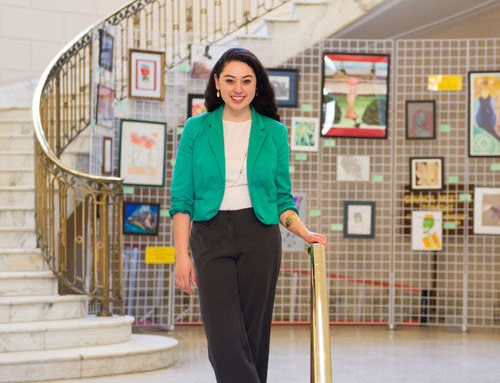 A spring semester course in digital photography added social media and camera phones into the mix. Is this the new norm?
A spring semester course in digital photography added social media and camera phones into the mix. Is this the new norm?
By Scott Quigley ’14
A 2013 Pew Research Center survey found that 58 percent of American adults own a smartphone, providing access to cameras and photo-sharing applications to nearly 240 million people. Another study projects that sales of smartphones with cameras will top 1.5 billion in 2014. The face—or at least the ease of digital photography—appears to be changing. So, does this affect how we should approach the art?
This spring, one class at the College explored how photography can live in the public realm of social media—using both industry-standard digital cameras and students’ smartphones.
Scott Fuller, associate professor of fine arts, leads the College’s digital photography course. This year, he wanted students to make photography a greater everyday activity, “to take a moment each day and think about taking a picture,” says Fuller. Sharing these images meant finding a photo-sharing platform and a method to make it easy to do, all of which led to the incorporation of using social media and camera phones in the course.
One student in Fuller’s class, business management and finance major Alex Markakis ’14, says his view of photography changed after being in the class, particularly the part of the course that involved uploading images to Instagram, a photo-sharing application with 150 million users. Before taking Fuller’s course, “I used to take pictures of whatever,” says Markakis. “Now I’m thinking about things like composition and converging lines.”
Students also realized there was more to photography than the omnipresent selfies found on social media sites, taken with their camera phones. “I was uploading stupid stuff, like selfies, parties, and food,” says business management major Jessica Capozzi ’14. “I put a lot more thought into photos now.”
Kimberly Post, director of community-based learning at the College, has practiced photography for most of her life, with a large portion of her work appearing in traditional gallery exhibits. But as far as cameras go, what’s her choice? She prefers the camera phone.
Post got her start in photography in the mid-1980s, developing her own prints in a darkroom. When she got an iPhone 3GS, though, she began using it as her main camera. Since then, she’s had her iPhone photos picked up for publication, most recently in The Art of iPhone Photography: Creating Great Photos and Art on Your iPhone (Rocky Nook, 2013).
“I think it’s great,” Post says. “It’s bringing photo-graphy to people who normally wouldn’t think about it. Everyone can be a photographer.”
For more photos from Fuller’s digital photography class, search Instagram using #sjcphotoclass and follow him at rdscottfuller.


